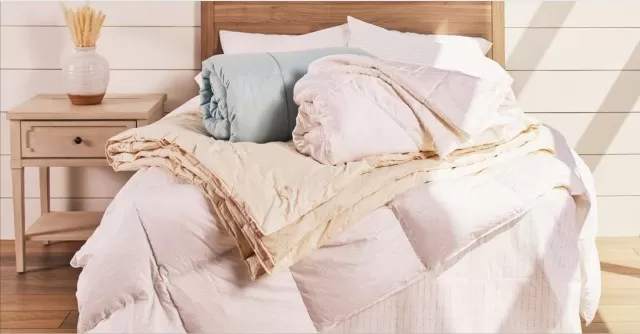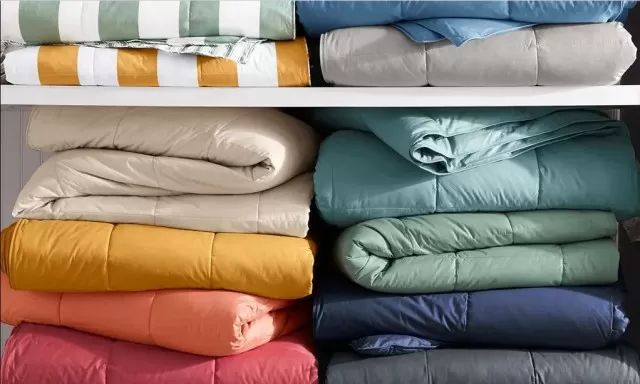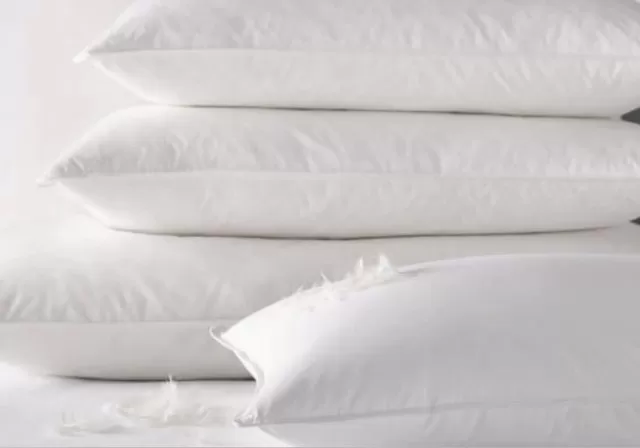Washing down pillows, comforters, and other down-filled items is often put off during laundry chores.
Many people even question whether it’s possible to wash a down comforter.
However, most of these items can be washed at home in a washing machine, despite their bulkiness. Manufacturers generally recommend cleaning down items every three to five years, so frequent washing is not necessary.
When the time comes to clean your down bedding or jackets, follow these steps for optimal results during the washing and drying process of down comforters, feather pillows, sleeping bags, and jackets.
Can you wash down comforters and pillows at home?

Comforters for larger bed sizes are typically too big for standard home washing machines.
For optimal results, it’s recommended to use a large-capacity Front-Loading Washing Machine, such as those found in laundromats. Down pillows, on the other hand, may be small enough to launder in your washing machine at home, especially if you have a front-loading machine.
If you have a top-loading machine, using a laundromat’s front-loading machines is advised, as the agitator in top loaders can be rough on delicate down items.
How to wash down pillows and Comforters: Always read and follow any specific instructions on the item’s care tag.
Before laundering, check for any worn stitching or holes and repair them with small stitches to prevent any loss of down during washing.
Before washing a down comforter or pillow, examine for tough stains like blood or urine.
Enzymatic cleaners work best for treating such stains, while color-safe bleach can be used for water or food stains. When spot-treating stains, pull the cover away from the down to protect it from potential damage caused by the cleaning product.
Once the stain is treated, the down item is ready for laundering.
What is the recommended wash cycle for down comforters and other down-filled items? Use a gentle or delicate cycle setting on your washing machine and use a mild laundry detergent in minimal amounts.
Opt for lukewarm water, as hot or cold water can be harsh on the down. An additional rinse cycle can help ensure all soap residue is removed from the down.
Specialty laundry detergents made specifically for washing down-filled items, such as sleeping bags and comforters, are also available and can be found online or at outdoor retailers.
To prevent the down from clumping together, add a pair of clean white canvas shoes (without laces) or a sock filled with two tennis balls to the machine with the comforter or pillows.
This will aid in gently agitating the items and removing soil.
Editor’s Tip: If your down jacket or pillow still has an odor after washing, don’t worry.
The distinctive wet odor is normal for down. It will dissipate as the down dries.
Dry Down Comforters and Pillows

How to Dry Down Items:
Once the washing process is finished, place your down comforter, pillows, or other down items in a dryer that is spacious enough to allow for ample movement.
To help fluff the down and distribute it evenly, add a pair of tennis balls enclosed in a sock or wool dryer balls in a sock.
What’s the Ideal Dryer Setting for Down Items?
Set the dryer to the air fluff or the lowest temperature setting available.
Periodically stop the dryer and break up any lumps that may form in the comforter or pillow. It’s crucial to ensure that the down is not subjected to excessive heat, as it can cause scorching.
Expect the drying process to take approximately three to four hours.
To prevent the formation of mildew, only remove the down item from the dryer when it is completely dry.
If the item is slightly damp, lay it out on a clothesline on a warm, breezy day to allow the down to dry as much as possible. After bringing the comforter or pillow indoors, leave it out for a few weeks to ensure that all moisture has evaporated.
If you intend to store the comforter, wrap it in a cotton sheet beforehand.
By following these instructions, you can effectively dry your down items, ensuring they are fully dry and ready for use or storage without any risk of mildew formation.
How frequently should you wash Down Comforters and Pillows

Some down comforters and pillows may have specific instructions to dry-clean rather than wash them.
To reduce the need for frequent washing, you can use a duvet cover to prevent oils from your skin from penetrating the comforter and attracting dirt.
To further protect the down, it’s recommended to always use a flat sheet underneath the duvet-covered comforter.
This sheet acts as an additional barrier against body oils and dirt. If no flat sheet is used, wash the duvet cover once a week.
If a flat sheet is used, the duvet cover can be washed once or twice a year.
For added defense against stains and dust mites, use pillow protectors and covers.
These covers usually have a zipper, allowing you to encase the pillow and easily remove it for washing. They can be made from cotton or cotton-polyester blends.
Just like a flat sheet provides extra protection for the duvet cover, these covers protect down pillows from stains and soil. It’s recommended to launder the pillowcase on a weekly basis.
A few times a year, you can freshen up a down comforter or down pillows by taking them outside on a warm, breezy day.
Place them on a flat surface in the sun for two to three hours before bringing them back inside.
Regardless of the type of down item you’re cleaning, always refer to the manufacturer’s care tag for specific instructions.
With this knowledge and a few tricks, you’ll be well-equipped to tackle the cleaning tasks for all your down-filled items, such as washing a down jacket, cleaning a duvet, and caring for feather pillows.
*The information is for reference only.